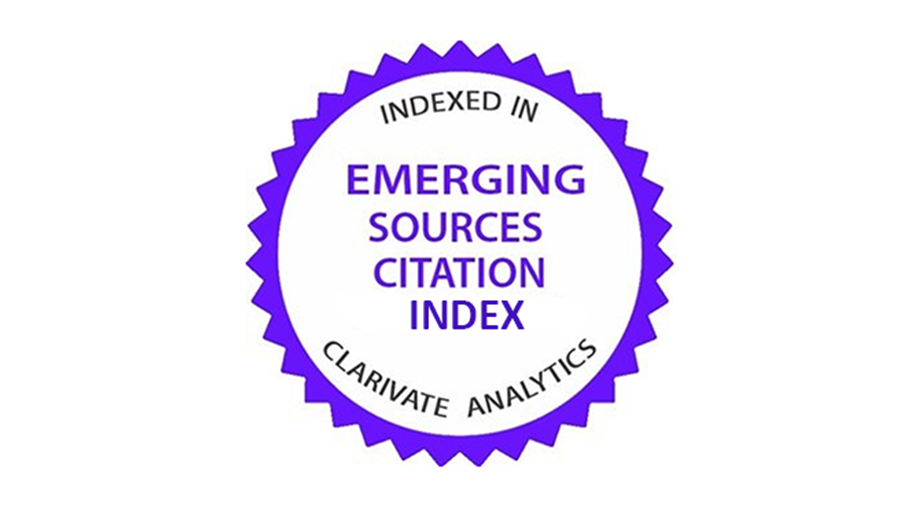Potassium Fractionation and Stock in Clay Soils: Influence of Geochemical and Mineralogical Properties in Yogyakarta Region, Indonesia
Abstract
Keywords
Full Text:
PDFReferences
Aji, K., Maas, A., & Nurudin, M. (2020). Relationship between soil morphology and variability of upland degradation in Bogowonto Watershed, Central Java, Indonesia. Journal of Degraded and Mining Lands Management, 7(3), 2209–2219. https://doi.org/10.15243/jdmlm.2020.073.2209
Akbas, F., Gunal, H., & Acir, N. (2017). Spatial variability of soil potassium and its relationship to land use and parent material. Soil and Water Research, 12(4), 202–211. https://dx.doi.org/10.17221/32/2016-SWR
Anda, M., Suparto, & Sukarman. (2016). Characteristics of pristine volcanic materials: Beneficial and harmful effects and their management for restoration of agroecosystem. Science of The Total Environment, 543, 480–492. https://doi.org/10.1016/j.scitotenv.2015.10.157
Anda, M., Suryani, E., & Subardja, D. (2015). Strategy to reduce fertilizer application in volcanic paddy soils: Nutrient reserves approach from parent materials. Soil and Tillage Research, 150, 10–20. https://doi.org/10.1016/j.still.2015.01.005
Babla, M. H., Donovan-Mak, M., Cazzonelli, C. I., Tissue, D. T., & Chen, Z. H. (2023). Linking high light-induced cellular ionic and oxidative responses in leaves to fruit quality in tomato. Plant Growth Regulation, 101(1), 267–84. https://doi.org/10.1007/s10725-023-01018-9
BBSDLP. (2017a). Atlas peta tanah semi detail skala 1:50.000, Kabupaten Bantul, Provinsi Daerah Istimewa Yogyakarta. Bogor, Indonesia: Research and Development of Agricultural Land Resources Center, Ministry of Agriculture.
BBSDLP. (2017b). Atlas peta tanah semi detail skala 1:50.000, Kabupaten Sleman, Provinsi Daerah Istimewa Yogyakarta. Bogor, Indonesia: Research and Development of Agricultural Land Resources Center, Ministry of Agriculture.
Bell, M. J., Ransom, M. D., Thompson, M. L., Hinsinger, P., Florence, A. M., Moody, P. W., & Guppy, C. N. (2021). Considering soil potassium pools with dissimilar plant availability. Improving potassium recommendations for agricultural crops, pp. 163–190. Springer. https://doi.org/10.1007/978-3-030-59197-7_7
Butler, B. M., Palarea-Albaladejo, J., Shepherd, K. D., Nyambura, K. M., Towett, E. K., Sila, A. M., & Hillier, S. (2020). Mineral–nutrient relationships in African soils assessed using cluster analysis of X-ray powder diffraction patterns and compositional methods. Geoderma, 375, 114474. https://doi.org/10.1016/j.geoderma.2020.114474
Demidchik, V., Straltsova, D., Medvedev, S. S., Pozhvanov, G. A., Sokolik, A., & Yurin, V. (2014). Stress‐induced electrolyte leakage: The role of K+‐permeable channels and involvement in programmed cell death and metabolic adjustment. Journal of experimental botany, 65(5), 1259–1270. https://doi.org/10.1093/jxb/eru004
Enang, R. K., Yerima, B. P. K., Kome, G. K., & Van Ranst, E. (2020). Soil physicochemical properties and geochemical indices: Diagnostic tools for evaluating pedogenesis in tephra-derived soils along the Cameroon volcanic line. Eurasian Soil Science, 53(8), 1079–1099. https://doi.org/10.1134/s1064229320080050
Fiantis, D., Ginting, F. I., Halfero, F., Saputra, A. P., Nelson, M., Van Ranst, E., & Minasny, B. (2021). Geochemical and mineralogical composition of the 2018 volcanic deposits of Mt. Anak Krakatau. Geoderma Regional, 25, e00393. https://doi.org/10.1016/j.geodrs.2021.e00393
Fiantis, D., Malone, B., Pallasser, R., Van Ranst, E., & Minasny, B. (2017). Geochemical fingerprinting of volcanic soils used for wetland rice in West Sumatra, Indonesia. Geoderma Regional, 10, 48–63. https://doi.org/10.1016/j.geodrs.2017.04.004
Hailu, H., Mamo, T., Keskinen, R., Karltun, E., Gebrekidan, H., & Bekele, T. (2015). Soil fertility status and wheat nutrient content in Vertisol cropping systems of central highlands of Ethiopia. Agriculture & Food Security, 4(1), 19. https://doi.org/10.1186/s40066-015-0038-0
Han, T., Huang, J., Liu, K., Fan, H., Shi, X., Chen, J., …, & Huimin, Z. (2021). Soil potassium regulation by changes in potassium balance and iron and aluminum oxides in paddy soils subjected to long-term fertilization regimes. Soil and Tillage Research, 214, 105168. https://doi.org/10.1016/j.still.2021.105168
Han, G.-Z., Huang, L.-M., & Tang, X.-G. (2019). Potassium supply capacity response to K-bearing mineral changes in Chinese purple paddy soil chronosequences. Journal of Soils and Sediments, 19(3), 1190–1200. https://doi.org/10.1007/s11368-018-2124-y
Han, T., Liu, K., Huang, J., Khan, M. N., Shen, Z., Li, J., & Zhang, H. (2023). Temporal and spatial characteristics of paddy soil potassium in China and its response to organic amendments: A systematic analysis. Soil and Tillage Research, 235, 105894. https://doi.org/10.1016/j.still.2023.105894
Harnois, L., & Moore, J. M. (1988). Geochemistry and origin of the Ore Chimney Formation, a transported paleoregolith in the Grenville Province of southeastern Ontario, Canada. Chemical Geology, 69(3–4), 267–289. https://doi.org/10.1016/0009-2541(88)90039-3
Harsha, B. R., & Jagadeesh, B. R. (2017). Studies on distribution of potassium fraction in surface and sub-surface layers of black soils. Journal of Pharmacognosy and Phytochemistry, 6(6), 2596–2601. Retrieved from https://www.phytojournal.com/archives/2017.v6.i6.2494/studies-on-distribution-of-potassium-fraction-in-surface-and-sub-surface-layers-of-black-soils
Hasanuzzaman, M., Bhuyan, M. H., Nahar, K., Hossain, M. S., Mahmud, J. A., Hossen, M. S., Masud, A. A., & Fujita, M. (2018). Potassium: A vital regulator of plant responses and tolerance to abiotic stresses. Agronomy, 8(3), 31. https://doi.org/10.3390/agronomy8030031
Heidari, A., Osat, M., & Konyushkova, M. (2022). Geochemical indices as efficient tools for assessing the soil weathering status in relation to soil taxonomic classes. CATENA, 208, 105716. https://doi.org/10.1016/j.catena.2021.105716
Irawan, W., & Putra, E. T. S. (2020). The effect of potassium addition on oil palm (Elaeis guineensis Jacq.) root anatomic properties under drought stress. Caraka Tani: Journal of Sustainable Agriculture, 35(1), 54–65. http://dx.doi.org/10.20961/carakatani.v35i1.32578
Jindaluang, W., & Darunsontaya, T. (2024). Role of soil organic carbon composition on potassium availability in smectite-dominated paddy soils. Journal of Soil Science and Plant Nutrition, 24, 1288–1300. https://doi.org/10.1007/s42729-024-01631-1
Kai-lou, L., Jing, H., Tian-fu, H., Ya-zhen, L., Dong-chu, L., Qaswar, M., …, & Hui-min, Z. (2022). The relationship between soil aggregate-associated potassium and soil organic carbon with glucose addition in an Acrisol following long-term fertilization. Soil and Tillage Research, 222, 105438. https://doi.org/10.1016/j.still.2022.105438
Kauer, K., Pärnpuu, S., Talgre, L., Eremeev, V., & Luik, A. (2021). Soil particulate and mineral-associated organic matter increases in organic farming under cover cropping and manure addition. Agriculture, 11(9), 903. https://doi.org/10.3390/agriculture11090903
Kitagawa, Y., Yanai, J., & Nakao, A. (2018). Evaluation of non-exchangeable potassium content of agricultural soils in Japan by the boiling HNO3 extraction method in comparison with exchangeable potassium. Soil Science and Plant Nutrition, 64(1), 116–122. https://doi.org/10.1080/00380768.2017.1411168
Kome, G. K., Enang, R. K., Tabi, F. O., & Yerima, B. P. K. (2019). Influence of clay minerals on some soil fertility attributes: A review. Open Journal of Soil Science, 09(09), 155–188. https://doi.org/10.4236/ojss.2019.99010
Kowalska, J. B., Skiba, M., Maj-Szeliga, K., Mazurek, R., & Zaleski, T. (2021). Does calcium carbonate influence clay mineral transformation in soils developed from slope deposits in Southern Poland? Journal of Soils and Sediments, 21(1), 257–280. https://doi.org/10.1007/s11368-020-02764-3
Laekemariam, F., Kibret, K., & Shiferaw, H. (2018). Potassium (K)-to-magnesium (Mg) ratio, its spatial variability and implications to potential Mg-induced K deficiency in Nitisols of Southern Ethiopia. Agriculture & Food Security, 7(1), 13. https://doi.org/10.1186/s40066-018-0165-5
Maier, C. R., Chen, Z. H., Cazzonelli, C. I., Tissue, D. T., & Ghannoum, O. (2022). Precise phenotyping for improved crop quality and management in protected cropping: A review. Crops, 2(4), 336–50. https://doi.org/10.3390/crops2040024
Moignien, R. (1966). Review of research on laterites. Paris: United Nations Educational, Scientific and Cultural Organisation. Retrieved from https://unesdoc.unesco.org/ark:/48223/pf0000071101
Mulyanto, D. (2020). Material volkanik sebagai penyusun utama tanah merah di atas batuan karbonat Karangsari Wonosari. Jurnal Tanah dan Air, 17(2), 45–55. https://doi.org/10.31315/jta.v17i2.4234
Navarro-Hasse, E., Yáñez, C., Neaman, A., & Pinochet, D. (2023). The effects of parent rock on soil clay mineralogy and soil physicochemical properties: A review. Idesia (Arica), 41(4), 125–139. https://doi.org/10.4067/S0718-34292023000400125
Négrel, P., Ladenberger, A., Reimann, C., Demetriades, A., Birke, M., & Sadeghi, M. (2023). GEMAS: Chemical weathering of silicate parent materials revealed by agricultural soil of Europe. Chemical Geology, 639, 121732. https://doi.org/10.1016/j.chemgeo.2023.121732
Nesbitt, H. W., & Young, G. M. (1984). Prediction of some weathering trends of plutonic and volcanic rocks based on thermodynamic and kinetic considerations. Geochimica et Cosmochimica Acta, 48(7), 1523–1534. https://doi.org/10.1016/0016-7037(84)90408-3
Nursyamsi, D., Idris, K., Sabiham, S., Rachim, D., & Sofyan, A. (2008). Dominant soil characteristics influencing available potassium on smectitic soils. Indonesian Journal of Agriculture, 1(2), 121–131. Retrieved from https://repository.pertanian.go.id/server/api/core/bitstreams/444bbfd2-b2a5-4dcf-b825-dbd257d6cfd4/content
Pathariya, P., Dwivedi, B. S., Dwivedi, A. K., Thakur, R. K., Singh, M., & Sarvade, S. (2022). Potassium balance under soybean–wheat cropping system in a 44 year old long term fertilizer experiment on a Vertisol. Communications in Soil Science and Plant Analysis, 53(2), 214–226. https://doi.org/10.1080/00103624.2021.1984516
Portela, E., Monteiro, F., Fonseca, M., & Abreu, M. M. (2019). Effect of soil mineralogy on potassium fixation in soils developed on different parent material. Geoderma, 343, 226–234. https://doi.org/10.1016/j.geoderma.2019.02.040
Pulungan, N. A., & Sartohadi, J. (2018). New approach to soil formation in the transitional landscape zone: Weathering and alteration of parent rocks. Journal of Environments, 5(1), 1–7. https://doi.org/10.20448/journal.505.2018.51.1.7
R Core Team. (2020). R: A language and environment for statistical computing. Vienna, Austria: R Foundation for Statistical Computing. Retrieved from https://cran.r-project.org/doc/manuals/r-release/fullrefman.pdf
Rahardjo, W., Sukandarrumidi, & Rosidi, H. M. D. (1995). Peta geologi lembar Yogyakarta skala 1:100.000. Bandung: Geological Research and Development Center. Retrieved from https://geologi.esdm.go.id/geomap/pages/preview/peta-geologi-lembar-kebumen-jawa
Rani, K., Datta, A., Jat, H., Choudhary, M., Sharma, P., & Jat, M. (2023). Assessing the availability of potassium and its quantity-intensity relations under long term conservation agriculture based cereal systems in North-West India. Soil and Tillage Research, 228, 105644. https://doi.org/10.1016/j.still.2023.105644
Rao, B. R., Bailey, J., & Wingwafi, R. W. (2011). Comparison of three digestion methods for total soil potassium estimation in soils of Papua New Guinea derived from varying parent materials. Communications in soil science and plant analysis, 42(11), 1259–1265. http://dx.doi.org/10.1080/00103624.2011.571740
Rawat, J., Sanwal, P., & Saxena, J. (2016). Potassium and its role in sustainable agriculture. Potassium solubilizing microorganisms for sustainable agriculture (pp. 235–253). New Delhi: Springer India. https://doi.org/10.1007/978-81-322-2776-2_17
Rizzo, G., Agus, F., Susanti, Z., Buresh, R., Cassman, K. G., Dobermann, A., ..., & Grassini, P. (2024). Potassium limits productivity in intensive cereal cropping systems in Southeast Asia. Nature Food, 5(11), 929–938. https://doi.org/10.1038/s43016-024-01065-z
Roaldset, E. (1972). Mineralogy and geochemistry of quaternary clays in the Numedal Area, southern Norway. Norsk Geolisk Tidsskrift, 52, 335–369. Retrieved from https://foreninger.uio.no/ngf/ngt/pdfs/NGT_52_4_335-369.pdf
Rosenstock, N. P., Stendahl, J., Van Der Heijden, G., Lundin, L., Mcgivney, E., Bishop, K., & Löfgren, S. (2019). Base cations in the soil bank: Non-exchangeable pools may sustain centuries of net loss to forestry and leaching. SOIL, 5(2), 351–366. https://doi.org/10.5194/soil-5-351-2019
Ruxton, B. P. (1968). Measures of the degree of chemical weathering of rocks. The Journal of Geology, 76(5), 518–527. https://doi.org/10.1086/627357
Sardans, J., & Peñuelas, J. (2021). Potassium control of plant functions: Ecological and agricultural implications. Plants, 10(2), 419. https://doi.org/10.3390/plants10020419
Sartohadi, J., Harlin Jennie Pulungan, N. A., Nurudin, M., & Wahyudi, W. (2018). The ecological perspective of landslides at soils with high clay content in the middle Bogowonto Watershed, Central Java, Indonesia. Applied and Environmental Soil Science, 2018(1), 2648185. https://doi.org/10.1155/2018/2648185
Soil Research Center. (1983). Terms of Reference. Soil Capability Survey. Soil Research Center: Department of Agriculture No.59/1983.
Soumare, A., Sarr, D., & Diédhiou, A. G. (2023). Potassium sources, microorganisms and plant nutrition: Challenges and future research directions. Pedosphere, 33(1), 105–115. https://doi.org/10.1016/j.pedsph.2022.06.025
Surono, Toha B., & Sudarno I. (1992). Peta geologi lembar Surakarta-Giritontro skala 1:100.000. Bandung: Geological Research and Development Center. Retrieved from https://geologi.esdm.go.id/geomap/pages/preview/peta-geologi-lembar-yogyakarta-jawa
Tavares, T. R., Nunes, L. C., Alves, E. E., Almeida, E. D., Maldaner, L. F., Krug, F. J., Carvalho, H. W., & Molin, J. P. (2018). Simplifying sample preparation for soil fertility analysis by X-ray fluorescence spectrometry. Sensors, 19(23), 5066. https://doi.org/10.3390/s19235066
Temga, J. P., Sababa, E., Mamdem, L. E., Bijeck, M. L. N., Azinwi, P. T., Tehna, N., …, & Ndjigui, P. (2021). Rare earth elements in tropical soils, Cameroon soils (Central Africa). Geoderma Regional, 25, e00369. https://doi.org/10.1016/j.geodrs.2021.e00369
Underwood, D. S., Yurchenko, S. N., Tennyson, J., & Jensen, P. (2014). Rotational spectrum of SO3 and theoretical evidence for the formation of sixfold rotational energy-level clusters in its vibrational ground state. The Journal of Chemical Physics, 140(24), 244316. https://doi.org/10.1063/1.4882865
van Reeuwijk, L. P. (2002). Soil testing methods. Global Soil Doctors Programme. Food and Agriculture Organization of the United Nations. Rome. Retrieved from https://www.isric.org/documents/document-type/technical-paper-09-procedures-soil-analysis-6th-edition
Van Reeuwijk, L. P. (2002). Technical paper 09: Procedures for soil analysis. International Soil Reference and Information Centre, Food and Agriculture Organization of the United Nations. Retrieved from https://www.isric.org/sites/default/files/ISRIC_TechPap09.pdf
Volf, M. R., Benites, V. M., Azevedo, A. C., Moraes, M. F., Tiritan, C. S., & Rosolem, C. A. (2023). Soil mineralogy and K reserves in soils from the Araguaia River valley, Brazil. Geoderma Regional, 33, e00654. https://doi.org/10.1016/j.geodrs.2023.e00654
Zareian, G., Farpoor, M. H., Hejazi-Mehrizi, M., & Jafari, A. (2018). Kinetics of non-exchangeable potassium release in selected soil orders of southern Iran. Soil and Water Research, 13(4), 200–207. https://doi.org/10.17221/138/2017-swr
Zörb, C., Senbayram, M., & Peiter, E. (2014). Potassium in agriculture – Status and perspectives. Journal of Plant Physiology, 171(9), 656–669. https://doi.org/10.1016/j.jplph.2013.08.008
Refbacks
- There are currently no refbacks.











